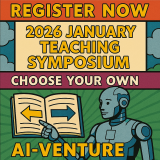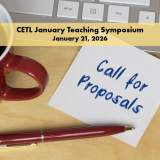
Tips for the Week of May 22, 2023
May 17, 2023
Cultivating Mutual Enjoyment for Sustainable Teaching
Historically, teaching has been considered a primarily cognitive activity; a transmission of knowledge from instructor to student. More recently, studies have explored the impact of emotion in the classroom and how it can shape the learning environment. When displayed by the instructor, positive emotions such as passion and enthusiasm can lead to increased student engagement and enjoyment, as “their emotional experiences during learning mirror our emotional experiences during teaching” (Cavanagh, 2023). Finding ways to reignite our love for teaching can lead to more positive experiences in the classroom, for both instructors and students. In planning for next term, Cavanagh suggests creating assignments that you find satisfying to evaluate, and to plan activities that you would enjoy doing yourself. Think about ways to engage your students in exploring the subject in ways that are enjoyable for them and for you. Finding joy in teaching also means giving ourselves time to rest, to do things outside of academia that are rejuvenating. It’s also important to consider “sustainable teaching” practices, which allow us to take care of ourselves and our students more effectively (Costa, 2022).
Reflective Thinking is a Professional Skill
Learning doesn’t come from experience; rather, learning comes from reflecting on an experience (John Dewey). “Reflection, or the ability to step back from an experience and consider it critically, in an analytical, non-subjective manner, is an essential aspect of problem solving and decision-making, and also of effective communication with clients, patients, and colleagues” (Adams, Nestel, & Wood, 2006, p. 58). Regardless of one’s discipline, reflective activities have the potential to deepen students’ knowledge and understandings, extend personal and professional perspectives, develop critical beliefs and dispositions, and hone work-related competencies. Are you harnessing the power of reflection to prepare your students for work after college? For more ideas in the professions, see reflection in healthcare and reflection in law school.
Where is Your Place on the Field?

Along with other economic, social, physical, mental, and emotional realities taxing today’s college students, stereotype threat and identity threat are particularly challenging for first-generation and non-majority students, taking up critical mental bandwidth that is then unavailable for learning (see Bandwidth Recovery for more). It is important to recognize that while students’ life experiences may have diminished their cognitive resources for learning, they are no different than their peers in terms of cognitive capacity. Understanding the ideas of privilege or lack of privilege can help students look at their life (and the lives of others) and the conditions that brought them to the present through different lenses. The analogy of the baseball field can be used to introduce privilege. Verschelden (2017) says, “I explain that a person in the United States who has inherited wealth and has done well in life can think that s/he hit a home run, not realizing that s/he was born on third base. I then ask the students where on the field they think they were born. We talk about why it is important to acknowledge that people are not all born to the same set of opportunities and that the relative amount of effort it takes to make it to home plate depends on where you started” (pp. 103-104) (More on privilege here).
Interested in exploring any of these ideas further or discussing how you might implement them in your own teaching practices? Is there a tip you’ve tried that you would like to share with colleagues? Contact CETL or schedule a consultation to continue the conversation.


